StructureSolver Value Proposition
- Using StructureSolver, interpreters can understand structural history, infer correlations across faults and validate fault and trap geometries, using a flexible and powerful combination of interpretation, modeling, and restoration.
- StructureSolver combines simplicity of use with technical rigor.
- Using StructureSolver, earth scientists can quickly and intuitively incorporate a high level of structural geological analysis in their seismic interpretations.
- StructureSolver is an attractive tool for basin analysts, explorationists, development geologists and structural geology specialists.
- StructureSolver is valuable for reviewing prospects and large interpretation projects
- Detailed geometrical understanding can be critical when wells are drilled close to faults. Because fault and bed shapes are quantitatively interrelated, both modeling and restoration can helps you fine tune the structural picture near faults.
- Likewise, both modeling and restoration can help you estimate deeper cross-fault correlations below well control or in frontier basins.
Mississippi Canyon Structural Model
This example illustrates how StructureSolver analysis can create value when analyzing large extensional growth faults, such as those found in the Gulf of Mexico and other passive continental margins. In such systems, the fault traces themselves may be well imaged using modern seismic data. Stratigraphic correlations may be well established from well control in the shallow section but unknown in the deeper section. Such systems often have very large displacements and interpreters quite often underestimate the amount of growth in the deep section.
In this example, StructureSolver is used to confirm the upper level stratigraphic correlations and to confirm and refine the fault shape. The combination of convex and concave curvatures on the fault provides significant geometric constraints. After this is done, a good estimate of the deeper stratigraphic correlations is readily obtained.
In some sections we have studied, there was very early salt movement in the core of the extensional growth structure. In such cases, careful analysis of discrepancies between the deep modeled and observed geometries can help you estimate the amount and timing of salt movement.
Step-by-step Sequence of Analysis
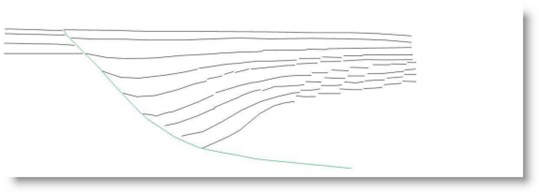 Import image of depth converted seismic interpretation; in this case a Mississippi Canyon growth fault from Xiao and Suppe(1991). Note the overall rollover together with “reverse drag” near the fault. The top four surfaces correlate on the footwall and hangingwall of the fault. The deepest five hangingwall surfaces have not been interpreted on the footwall side of the fault.
Import image of depth converted seismic interpretation; in this case a Mississippi Canyon growth fault from Xiao and Suppe(1991). Note the overall rollover together with “reverse drag” near the fault. The top four surfaces correlate on the footwall and hangingwall of the fault. The deepest five hangingwall surfaces have not been interpreted on the footwall side of the fault.
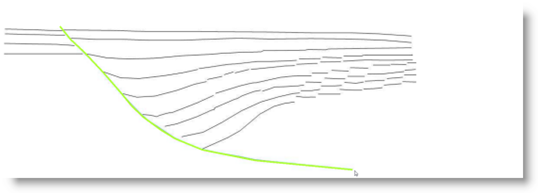
Digitize fault trajectory in StructureSolver – assuming that the existing interpretation is correct (which will be confirmed).
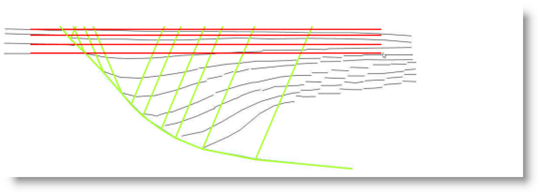 Add the uppermost four undeformed uppermost surfaces at their footwall levels. The synthetic and antithetic shear surfaces are automatically displayed.
Add the uppermost four undeformed uppermost surfaces at their footwall levels. The synthetic and antithetic shear surfaces are automatically displayed.
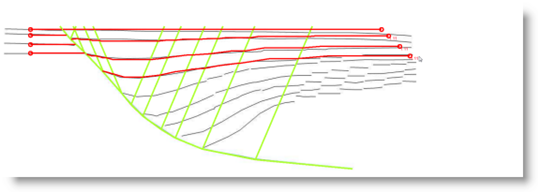 Stretch the hanging wall layers by a constant growth factor by dragging the deepest surface with the cursor. The model geometry conforms very well with the observed shapes, confirming that the fault shape is indeed controlling deformation. The main rollover is caused by the concave bends on the fault, the “reverse drag” by the small convex bends.
Stretch the hanging wall layers by a constant growth factor by dragging the deepest surface with the cursor. The model geometry conforms very well with the observed shapes, confirming that the fault shape is indeed controlling deformation. The main rollover is caused by the concave bends on the fault, the “reverse drag” by the small convex bends.
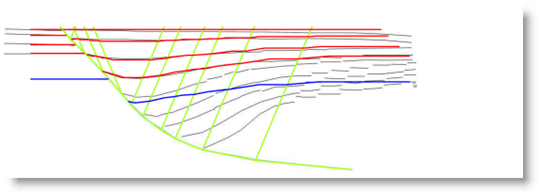 Add a surface corresponding to the deepest hangingwall surface. By default, it is assumed that the reference thickness of the overlying layer is the same on the footwall side of the fault (no growth). Because the structure does not match this assumption is clearly incorrect.
Add a surface corresponding to the deepest hangingwall surface. By default, it is assumed that the reference thickness of the overlying layer is the same on the footwall side of the fault (no growth). Because the structure does not match this assumption is clearly incorrect.
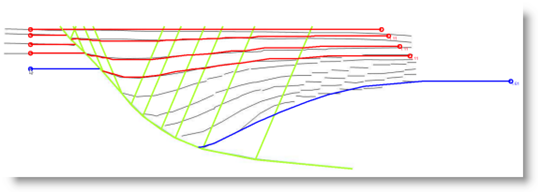 Match the deepest structural surface by dragging the footwall surface upwards, thereby reliably establishing the footwall correlation of the deepest hangingwall surface.
Match the deepest structural surface by dragging the footwall surface upwards, thereby reliably establishing the footwall correlation of the deepest hangingwall surface.
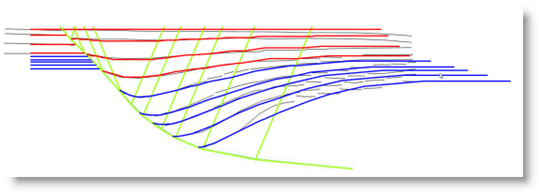 Add intervening surfaces that match the hanging wall cutoff. The model is now complete and accounts for about 90% of the observed structure. The fault trajectory and deformational mechanism is confirmed and deeper correlations established.
Add intervening surfaces that match the hanging wall cutoff. The model is now complete and accounts for about 90% of the observed structure. The fault trajectory and deformational mechanism is confirmed and deeper correlations established.
NW Africa Continental Shelf Restoration
This example illustrates how StructureSolver structural restoration can be used to quickly test cross-fault correlations of seismic reflectors in situations where you do not have stratigraphic control from wells.
The data transformation provided by restoration also highlights a major stratigraphic sequence boundary.
StructureSolver restoration is a much superior technique to the simple flattening option that is available in many interpretation systems.
Data courtesy TGS-Nopec.
- Estimation of deep fault trajectories becomes critical as deeper targets are explored.
- Similarly estimation of fault detachment geometries is important when trying to understand basin structural kinematics and dynamics.
New Zealand Crustal Fault Structural Model
Lock Hangingwall Cutoffs menu item was deprecated in Version 2.2.
StructureSolver locks hangingwall cutoffs automatically as required and previous menu option has been removed. Hangingwall cutoffs are locked whenever a more surface is moved on the footwall side of the fault and whenever the bottom segment of a fault is modified in any way. This makes the modeling process much simpler and more intuitive.
Modeling a Growth Fault in the Niger Delta
This simple example shows how StructureSolver structural modeling can be used to sequentially:
- Confirm a well-imaged fault trajectory
- Establish good estimates of cross-fault correlations
- Constrain the deeper fault trajectory beyond the limit of seismic control.
Data courtesy of TGS-Nopec.
- StructureSolver can elucidate the kinematic interaction between major faults and can also show how minor synthetic or antithetic faults relate to the geometry of major faults.
- Understanding such interactions can be critical in assessing trap integrity relative to migration timing.
Rhone Delta Structural Model
The seismic section from the Rhone Delta extension shows a complex extension patten above a shallow dipping weak detachment.
Despite the structural complexity most of the structural development can be modeled using two listric faults.
- Movement on the left fault generally predates movement on the right fault, although there is a period of overlap. The left fault has a simple listric shape. The net effect of growth across this fault is simple rotational fanning.
- The right fault has a convex pillow superimposed on its overall listric shape (probably associated with movement on the left fault). Synthetic deformation axes associated with this pillow produce the pronounced syncline. The structural deformation pattern could not be effectively modeling without taking into account both synthetic and antithetic shear axes. In the observed section there are numerous small synthetic faults whose patten matches the modeled shear pattern.
The modeling quite strongly constrains the correlations across both faults.
Data courtesy of TGS-Nopec.
In both extensional and contractional structural settings, growth sediments may be deposited as faults are moving. The thickness and type of sediments vary in response to the structural accommodation space that is provided. Growth sediments are then further deformed. StructureSolver lets you model and understand such relationships in a straightforward way, which is often critical in play analysis.
Stratigraphic features on seismic sections are often dissected and obscured by the effects of post-depositional faulting. StructureSolver lets you restore such tectonically-masked features so that original stratigraphic relationships are made clear.
- StructureSolver is an invaluable tool for interpreters who are working on complex 3D interpretation projects
- Many 3D interpretations in complex structural regimes are begun and even completed without understanding the structural kinematic framework. Consequently, errors in fault shape and cross-fault correlation are often propagated through the interpretation. These errors are either expensively corrected at later stages, or if not corrected, may adversely impact exploration and development success.
- Using a combination of StructureSolver modeling and restoration, an interpreter can rapidly validate the overall structural kinematic framework at the beginning of an interpretation and refine the framework throughout the process. This approach dramatically shortens the interpretation cycle and reduces the need for rework.
- Because StructureSolver can easily import and calibrate screen images, this type of analysis can be done on a PC independently of the core interpretation software that the interpreter is using. It often takes less than 15 minutes to complete a StructureSolver analysis starting with a simple screen capture from a seismic interpretation system. This investment will pay off many times over.
- StructureSolver can be used to teach structural principles using real time interactive model building and animation. StructureSolver brings the principles of fault-related deformation and sedimentary growth to life in ways that diagrams and equations cannot.
- After a short period of guided experimentation using StructureSolver, geologists will fully grasp the critical relationships between fault shapes, growth rates and fold geometries.
Inversion Model
This example illustrates how simple it is to create a model with combined extensional and contractional growth. You just need to put a little thought into the sequence in which you add surfaces and move surfaces. Note how you can construct a partial model and then extend it automatically by adding points to the fault. This illustrates the flexibility of the StructureSolver workflow.
Examples like this provide value in structural geology training.
- Geologists can also use restorations of synthetic and real geological structures to improve their appreciation of structural sequencing.
Restoration Basics
- By working through simple "what-if" scenarios geologists quickly appreciate how much valuable information can be obtained from geometric analysis in both extensional and contractional regimes.

